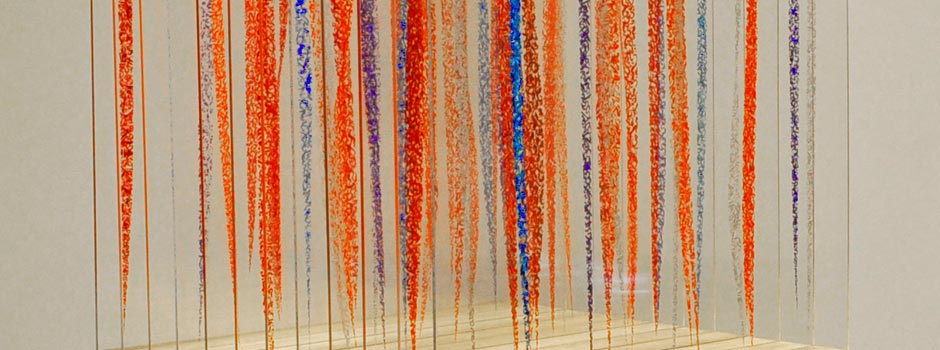
An Interview with Multimedia Artist Shafaq Ahmad The Message of Multicultural Awareness
Feb 08, 2013 Interview

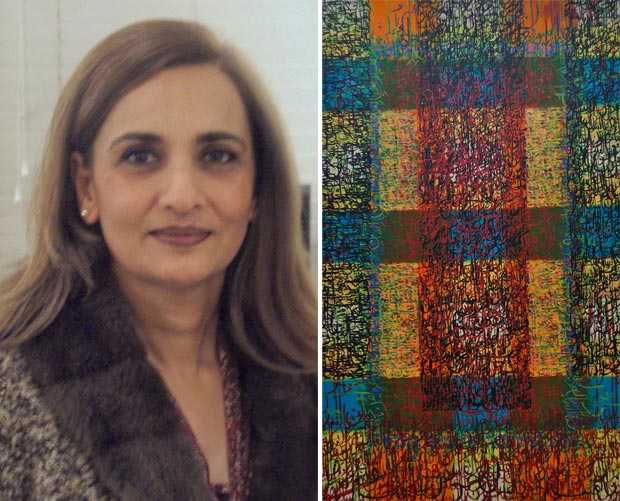 Shafaq Ahmad / photo on the right: Iqrar, 36x60 in, Oil on canvas, 2010 / Courtesy of the Artist
Shafaq Ahmad / photo on the right: Iqrar, 36x60 in, Oil on canvas, 2010 / Courtesy of the Artist
Shafaq Ahmad, a multimedia artist, was born in Rawalpindi, Pakistan. She left Pakistan at age 20 and lived in the United Kingdom, Iran and Denmark before settling down in the United States. She graduated Summa Cum Laude with a Bachelor of Fine Art degree from Virginia Commonwealth University in Richmond, Virginia in 1991 and a Masters of Fine Art degree from Texas Christian University in Fort Worth, Texas in 2011.
Ahmad worked as an art glass designer from 1995 to 2003 and collaborated with several art glass studios in the Czech Republic and Sweden. Her art glass designs are in private collections in many countries. Now an international artist who has won awards for her work, she is represented by Mica Gallery in London. She has participated in several prestigious international exhibitions. Her work is found in many public collections in the USA, including the Madi Museum of Geometric Art in Dallas, Texas.
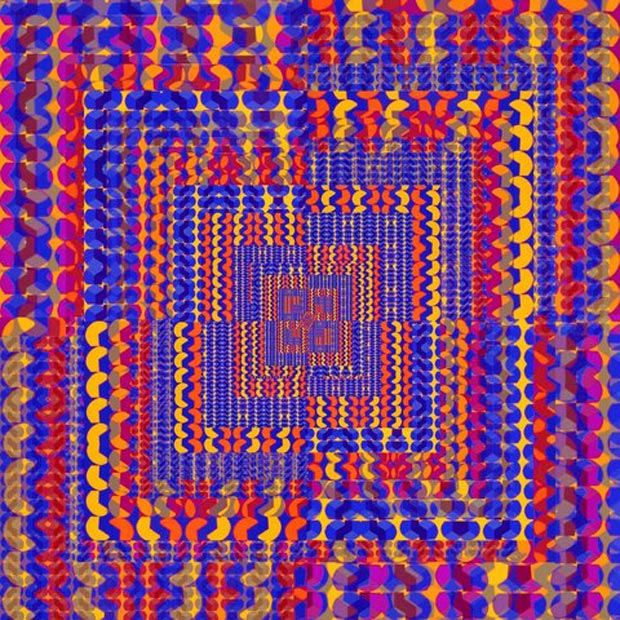 Shafaq Ahmad / Geometric abstractions, pigment on paper, 2012 / Courtesy of the Artist
Shafaq Ahmad / Geometric abstractions, pigment on paper, 2012 / Courtesy of the Artist
All the countries I lived in before moving to the U.S. influenced my work later. I was inspired to create work that would appeal to a large audience. I want the viewer to connect with the artwork on many levels, which could be purely a visual experience or it could be emotional or spiritual or an intellectual connection.
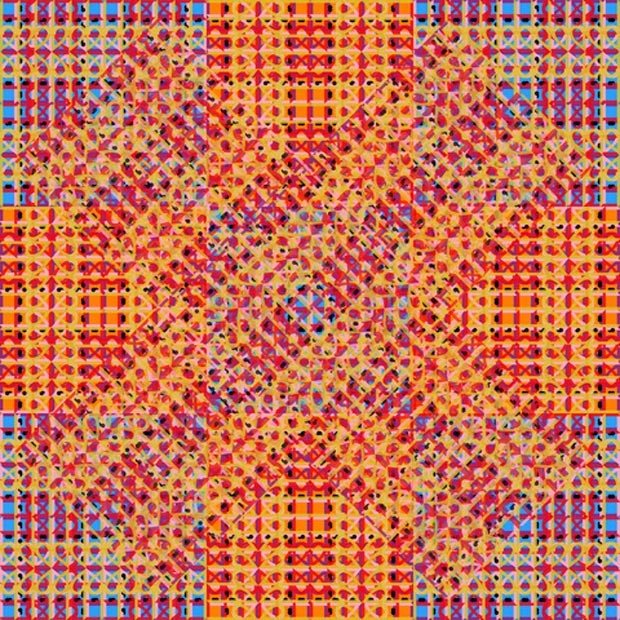 Shafaq Ahmad / Mystical letters, pigment on paper, variable size, 2012 / Courtesy of the Artist
Shafaq Ahmad / Mystical letters, pigment on paper, variable size, 2012 / Courtesy of the Artist
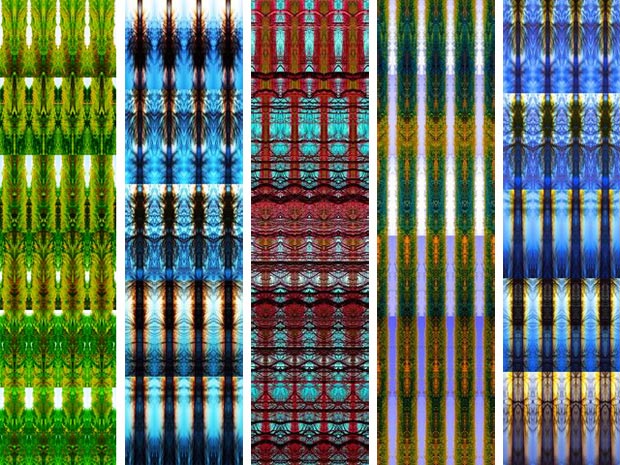 Shafaq Ahmad / Making the invisible visible, the hidden geometry in nature, pigment on canvas, each 15x60 in, 2012 / Courtesy of the Artist
Shafaq Ahmad / Making the invisible visible, the hidden geometry in nature, pigment on canvas, each 15x60 in, 2012 / Courtesy of the Artist
As I have had a chance to experience various cultures during my stay in different countries and my extensive travels, it has shaped me as an artist who wants to relate to people of all religions and ethnic backgrounds. What people believe or how they express themselves may be different but I feel at a basic level all people are similar and require the same things out of life, like love, compassion, understanding and spiritual attainment and growth.
 Shafaq Ahmad / Faith and identity, Mixed media on canvas, ​36x36 in, 2012 / Courtesy of the Artist
Shafaq Ahmad / Faith and identity, Mixed media on canvas, ​36x36 in, 2012 / Courtesy of the Artist
 Shafaq Ahmad / Faith and identity, Mixed media on canvas, ​36x36 in, 2012 / Courtesy of the Artist
Shafaq Ahmad / Faith and identity, Mixed media on canvas, ​36x36 in, 2012 / Courtesy of the Artist
Yes, I am a multimedia artist. Other than oil painting, I like to use other media to try and connect to as wide an audience as possible. The basic theme of my work is Islamic mysticism. When I start to work on a piece, for the most part it is spontaneous and the process itself is highly meditative. I am very much absorbed in the meditative act of making the work, where my mind goes blank, and I have to pull myself back to evaluate the formal aspects of the work every once in a while and at the end of the process.
Transparent veils is a good example of a spontaneous idea to make a solid cube and on top a transparent cube made up of several panels of transparent glass painted with the beautiful names of Allah in Arabic calligraphy. Although at the time I did not realize why I wanted to make this piece, later I understood that the solid cube represents for me the hidden aspect of God and the glass panels are the dissolving veils that are allowing me to see beyond the hidden and into the beauty of the Creator. Of course there are many other mystical explanations that can be brought forth.
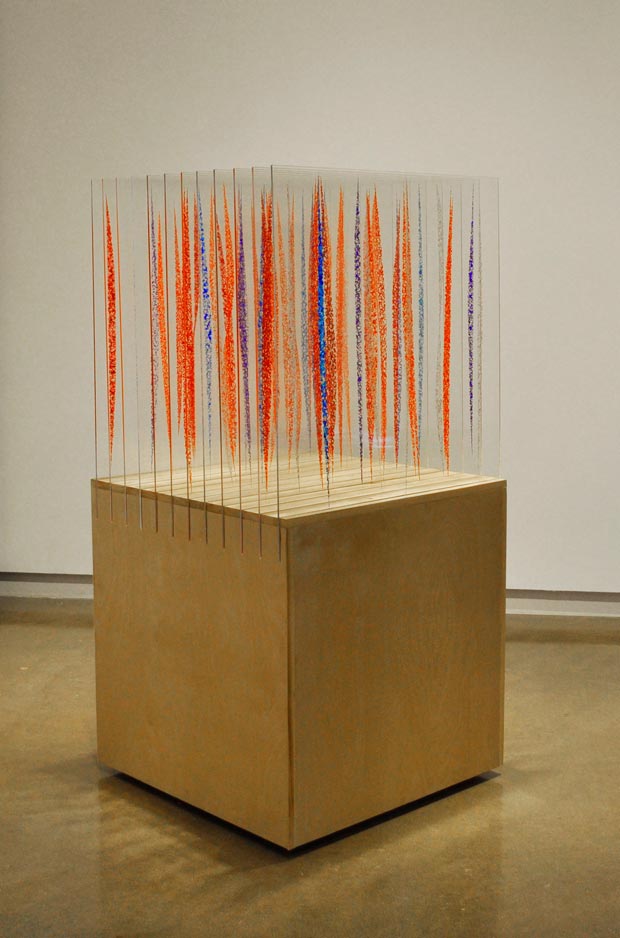 Shafaq Ahmad / Transparent Veils, Wood, oil paint and plexiglass, Plexiglass 86.5 x 76cm, Plinth 78.5x76x76 cm, 2010 / Courtesy of the Artist
Shafaq Ahmad / Transparent Veils, Wood, oil paint and plexiglass, Plexiglass 86.5 x 76cm, Plinth 78.5x76x76 cm, 2010 / Courtesy of the Artist
As I mentioned before the process of painting is highly meditative for me and the pieces are created while meditating on the Most Beautiful Names.
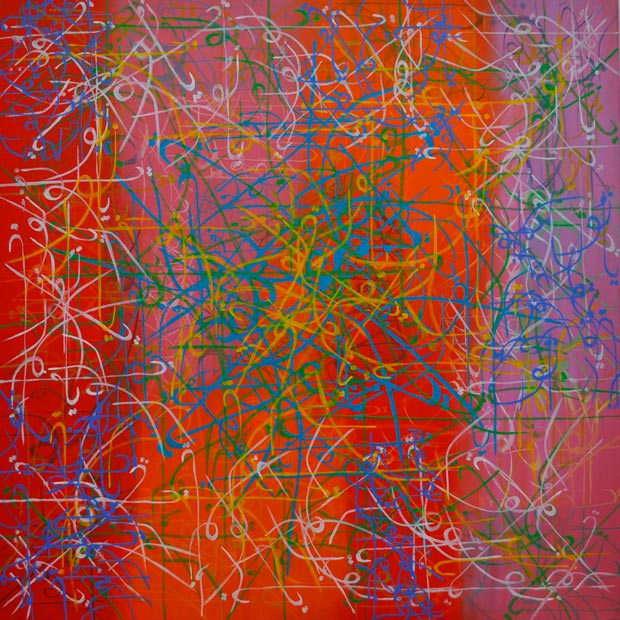 Shafaq Ahmad / Ya Noor, Oil on canvas, 48x48 in, 2009 / Courtesy of the Artist
Shafaq Ahmad / Ya Noor, Oil on canvas, 48x48 in, 2009 / Courtesy of the Artist
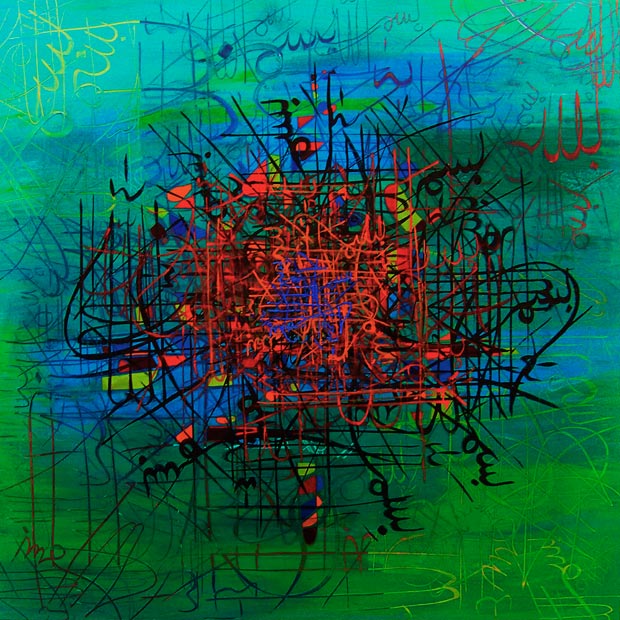 Shafaq Ahmad / Bismillah, Oil on canvas, 48x48 in, 2009 / Courtesy of the Artist
Shafaq Ahmad / Bismillah, Oil on canvas, 48x48 in, 2009 / Courtesy of the Artist
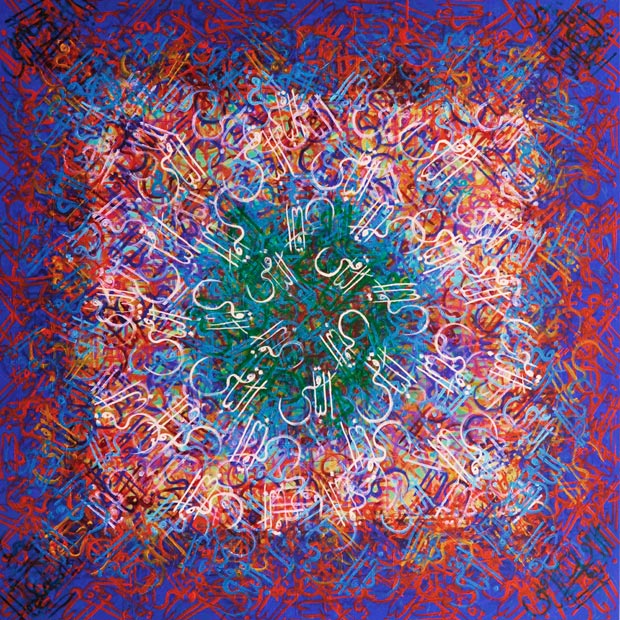 Shafaq Ahmad / Al Baki, Oil on canvas, 48x48 in, 2010 / Courtesy of the Artist
Shafaq Ahmad / Al Baki, Oil on canvas, 48x48 in, 2010 / Courtesy of the Artist
Yes. The center point is represents the point of origin where life of every thing in the Universe begins and goes back to. And radiating from the central point represents the enveloping and all encompassing energy or light of the Creator.
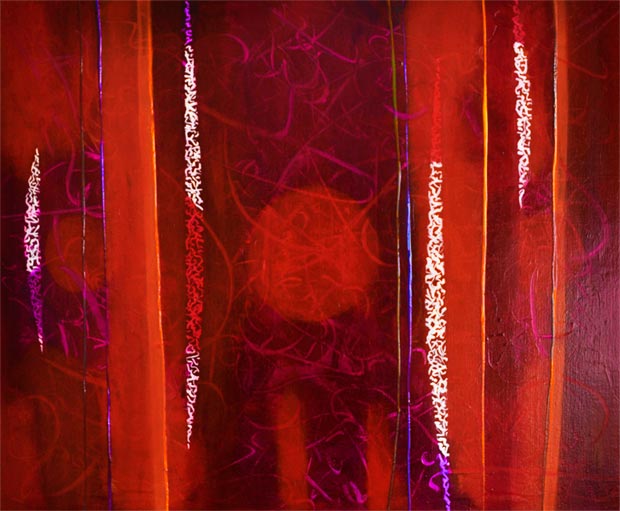 Shafaq Ahmad / Ya Rahim, Oil on linen, 20x24 in, 2011 / Courtesy of the Artist
Shafaq Ahmad / Ya Rahim, Oil on linen, 20x24 in, 2011 / Courtesy of the Artist
The repetitive calligraphy is a way to meditate like in Zikr or Tasbeeh on the names of Allah. I feel that the meaning of each word is absorbed in me while meditating on it. The layered calligraphic marks represent the intertwined lives of people of all backgrounds and nations and the similarities that exist all around the world among them creating a multicultural fabric.
Arabic text was and is an integral part of my life as a Muslim growing up. It evokes an emotional, spiritual and visual experience of beauty for me. The beauty of the Arabic letters is known all over the world and appreciated by many Muslims and non-Muslims alike. Even if the viewer is not able to read the text I hope that they can appreciate the beauty of the flowing letters, the intense colors and the feeling of all encompassing space that I try to create.
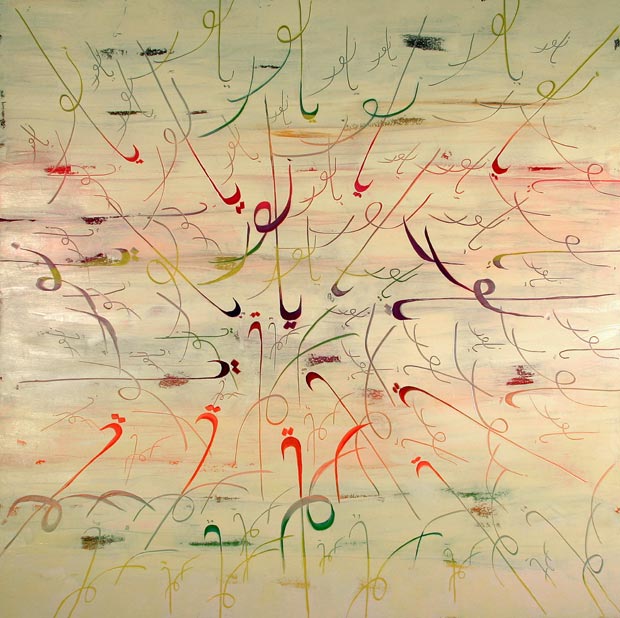 Shafaq Ahmad / Ya Noor, Oil on canvas,2009 / Courtesy of the Artist
Shafaq Ahmad / Ya Noor, Oil on canvas,2009 / Courtesy of the Artist
I do like to work in a large format. I like to move my whole body while I work which allows me to be in a way part of the space that is being created in the art work and also be part of the energy that is being created. The intense colors show my passion and love I feel as an artist and for life. The choice of colors in each work is also very spontaneous. I am sure that partly the choice of colors is due to my cultural background as I grew up in Pakistan where color in all things seemed to be revved up.
 Shafaq Ahmad / Ya Kareem, Oil on canvas, 60x60 in, 2010 / Courtesy of the Artist
Shafaq Ahmad / Ya Kareem, Oil on canvas, 60x60 in, 2010 / Courtesy of the Artist
That I continue to paint and work in other media. I want to explore digital media further and work in 3D experimenting with a larger scale. I am also presently in the process of collaborating with art galleries in Pakistan and the Middle East.
Comments
Add a comment